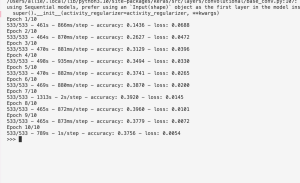What did you personally accomplish this week on the project? Give files or photos that demonstrate your progress. Prove to the reader that you put sufficient effort into the project over the course of the week (12+ hours.
I spent some time on my original dataset processing code, but I had to abandon it since we had to switch datasets and the new dataset that we picked needed to be processed in a different way. We switched dataset because I discovered that our original dataset did not label each picture with the attributes we needed(style, color, fabric). Many pictures were just labeled with non-exhaustive list of a few attributes. For example, most pictures weren’t labeled with a color at all, which made this dataset unsuitable for our application because color is a crucial thing we need to classify by. I then wrote code to process the dataset and train a classification model, with a common neural network architecture used for image classification. The training data and the model architecture will be fine-tuned later, this is just to have the basic structure working. With this baseline code, I was able to achieve an accuracy of 40%, which is much lower than we need.

I did research on the best neural network architecture to use for our image classification situation, and found that a convolutional one works well because it scans chunks of the image, allowing them to learn features like colors and shapes. They are translation-invariant, meaning they will be able to classify a piece of clothing regardless of where it is located in the frame. They also don’t need as many parameters as a fully connected network, which works well for our application as this will reduce the model size which is beneficial for ML on an edge device. We will use pooling layers as they make the network more invariant to small distortions, which is helpful since we are unsure of how good our camera feed will be, and because they speed up computation which will help us with our speed constraint. I chose to use the sigmoid function to determine label probabilities since sigmoid is the most suitable for multilabel classification due to producing independent probabilities for each label. I also did some research on pretrained models that we could possible use(just for risk mitigation). This information is located in the team report. I also worked on the script and slides for the design presentation as well as our design report.
Is your progress on schedule or behind? If you are behind, what actions will be taken to catch up to the proiect schedule?
My progress is on schedule.
What deliverables do you hope to complete in the next week?
I hope to finish the model classification by achieving the accuracy desired. I hope to also start on creating predefined outfits. I also hope to finish the Design Report.
